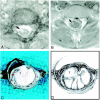Diffuse leptomeningeal oligodendrogliomatosis: radiologic/pathologic correlation
- PMID: 10871026
- PMCID: PMC7973905
Diffuse leptomeningeal oligodendrogliomatosis: radiologic/pathologic correlation
Abstract
We present the radiologic and pathologic findings in a boy who presented with diffuse leptomeningeal enhancement and whose clinical status deteriorated over the course of 5 years. During this period, MR images showed progression of the enhancement in the subarachnoid spaces, formation of intraaxial cysts, and hydrocephalus. Autopsy findings revealed diffuse oligodendroglioma throughout the leptomeninges of the brain and spine, with no definite intraaxial focus. The radiologic and pathologic features of diffuse leptomeningeal oligodendrogliomatosis are reviewed.
Figures






References
-
- Beck DJK, Russell DS. Oligodendrogliomatosis of the cerebrospinal fluid pathway. Brain 1942;65:352-372
-
- Perentes E, Rubinstein LJ. Recent applications of immunoperoxidase histochemistry in human neuro-oncology. Arch Pathol Lab Med 1989;111:796-812 - PubMed
-
- Russell DS. Observations on the pathology of hydrocephalus. In: Medical Research Council, Special Report, Series No. 265. London: His Majesty's Stationary Office; 1949 112-113
-
- Michel D, Lemercier G, Beau G, Tommasi M, Schott B. Gliomatose méningée et ventriculaire diffuse secondaire à un oligodendrogliome intramédullaire: a propos d'une observation. Lyon Med 1975;234:37-41
-
- Toso V. Diffusioni metastiche alle leptomeningi. Acta Neurol Napoli 1967;22:366-376 - PubMed
Publication types
MeSH terms
LinkOut - more resources
Full Text Sources
